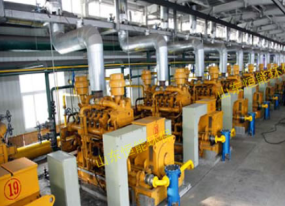1.運營管理不到位。運行中,脫硫液溫度過高,一般控制在38-42℃為宜。高于45℃,氣泡易碎,元素硫浮選差,生成的次生鹽多。一般三種二次鹽(Na2S2O3Na2SO4NaCNS)之和應小于250 g/L,隨著副反應的增多,容易析出結晶,形成鹽堵。鹽堵后不僅塔阻增大,而且設備腐蝕嚴重。鹽堵后,再好的催化劑也無能為力;從氧化再生罐中飄出的硫磺氣泡不能及時溢出,在液面停留時間過長。硫磺氣泡破碎后落下,在溶液中形成懸浮的硫磺,由脫硫泵帶入塔內,沉積在填料上。時間長了,硫塞就形成了。溶液循環量不能保持穩定,調節過于頻繁。當它減少時,可以從溶液的組成進行一些調整。運行后,吹煉強度可以穩定在一個較好的量上,一般不宜做太大的調整,否則會影響元素硫的浮選,導致再生成果不佳。
1. Inadequate operational management. During operation, the temperature of the desulfurization solution is too high, and it is generally recommended to control it at 38-42 ℃. Above 45 ℃, bubbles are fragile, elemental sulfur flotation is poor, and more secondary salts are generated. Generally, the sum of the three secondary salts (Na2S2O3Na2SO4NaCNS) should be less than 250 g/L. With the increase of side reactions, it is easy to precipitate crystals and form salt blockage. After salt blockage, not only does the tower resistance increase, but also the equipment suffers from severe corrosion. After salt blockage, even a good catalyst is powerless; The sulfur bubbles floating out of the oxidation regeneration tank cannot overflow in a timely manner and remain on the liquid level for a long time. After the sulfur bubbles break, they fall and form suspended sulfur in the solution, which is brought into the tower by the desulfurization pump and deposited on the packing. Over time, sulfur plugs form. The circulation volume of the solution cannot be kept stable and adjusted too frequently. When it decreases, some adjustments can be made from the composition of the solution. After operation, the blowing strength can be stabilized at a good level, and it is generally not advisable to make too large adjustments, otherwise it will affect the flotation of elemental sulfur and lead to poor regeneration results.
2.催化劑選擇不當,劣質催化劑雖然價格低廉,但在沼氣脫硫設備應用過程中,塔內析出的單質硫不能及時隨溶液取出,會長期堵塞塔,嚴重影響生產。
2. Improper selection of catalysts. Although low-quality catalysts are cheap, during the application of biogas desulfurization equipment, the elemental sulfur released from the tower cannot be removed with the solution in a timely manner, which can cause long-term blockage of the tower and seriously affect production.

3.進塔氣體質量差,氣體夾帶的煤灰、煤焦油等雜質長期堆積在填料上,造成塔阻力增大,堵塞脫硫設備。
3. The quality of gas entering the tower is poor, and the impurities such as coal ash and coal tar carried by the gas accumulate on the filler for a long time, which increases the tower resistance and blocks the desulfurization equipment.
4.80%的脫硫吸收和硫沉淀反應是在脫硫設備中進行的。塔內析出的硫不能及時隨脫硫液帶出塔外,較易粘在填料表面,時間長了導致氣偏、堵塔。
4.80% of desulfurization absorption and sulfur precipitation reactions are carried out in desulfurization equipment. The sulfur precipitated inside the tower cannot be brought out of the tower in a timely manner with the desulfurization liquid, which is more likely to stick to the surface of the filler, leading to gas deviation and tower blockage over time.
5.溶液循環量小,噴霧密度降低。一般要求噴淋密度為35-50 m3/㎡h,容易使塔內填料形成干燥區,氣液接觸不好,會降低脫硫效率。時間長了會形成局部堵塞,氣液偏移,塔阻力增大,造成脫硫設備堵塞。
5. The solution circulation is small, and the spray density decreases. The general requirement is for a spray density of 35-50 m3/㎡/h, which can easily cause the filling material in the tower to form a dry area. Poor gas-liquid contact can reduce desulfurization efficiency. Over time, local blockage may occur, resulting in gas-liquid deviation, increased tower resistance, and blockage of desulfurization equipment.
6.脫硫系統設備有問題。一是設備填料選擇不當,脫硫設備氣液分布器、再分布器、除霧器結構不合理或安裝有偏差。脫硫設備檢修時,只將塔內填料拔出清洗,而除霧器和駝峰板之間堆積的碎填料和硫磺沒有及時清理干凈,造成除霧器和駝峰板的降液管孔不通暢,以致啟動后氣體跑偏,塔阻上升。二是溶液再生有問題,硫浮選效率差,懸浮硫上升,脫硫效率下降。主要表現為再生沼氣脫硫設備不配套,氧化再生罐設計存在缺陷。
6. There is a problem with the desulfurization system equipment. One is the improper selection of equipment fillers, as well as the unreasonable structure or installation deviation of the gas-liquid distributor, redistributor, and mist eliminator of the desulfurization equipment. During the maintenance of desulfurization equipment, only the packing inside the tower was pulled out for cleaning, while the accumulated crushed packing and sulfur between the mist eliminator and the hump plate were not cleaned in a timely manner, resulting in unobstructed downcomer holes of the mist eliminator and hump plate, resulting in gas deviation and tower resistance rising after startup. Secondly, there are problems with solution regeneration, such as poor sulfur flotation efficiency, an increase in suspended sulfur, and a decrease in desulfurization efficiency. The main manifestation is that the regeneration biogas desulfurization equipment is not matched, and there are defects in the design of the oxidation regeneration tank.
Thank you for reading. The source of this article is biogas desulfurization. For more information and questions, please click on: http://lbflj.com We will continue to work hard to provide you with services. Thank you for your support!
